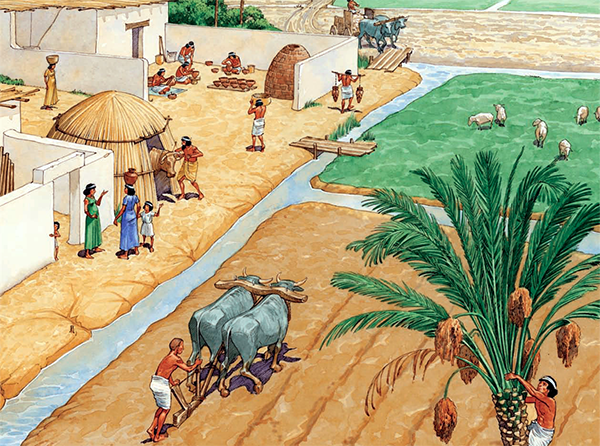Arising ancient civilizations in Egypt, the Near East, India, and China were impacted by vast river valley systems that sustained growth and prosperity.
Most of the great Ancient civilizations arose around river valley communities, coinciding with the late Neolithic period and the emergence of the Agricultural Revolution. As such, these river valley communities had similar origins and formed the backbone of growing communities that would eventually be considered empires, dominating entire geographic regions. Such developments can be charted in Egypt, the Near East, India, and China. The development of culture within each of these communities followed similar patterns, largely due to sedentarization associated with great river valleys.
Common Developmental Trends in Ancient River Valley Civilizations
Civilizations emerging along the Nile, Tigris, Euphrates, Indus, and Yellow Rivers transformed nomadic societies into permanent dwellers through processes that included common elements. Among these are:
- The construction of early settlements that led to city-building
- Use of livestock and the development of agriculture generally associated with one or two primary crops
- Development of religious beliefs tied to the environment
- Growth of a political system
- Development of trade and commerce
- Social class structure identification
- Creation of a social and cultural self-identity peculiar to each different emerging society
- Beginning of a written tradition for record keeping and religious practices
- Military innovations for protection and for conquest
Late Neolithic Migrations to River Valley Settlements
Although each river valley civilization saw migration and settlement at slightly different periods (The Near East/Mesopotamia and Egypt ca 8000 B.C.E.; China and India ca 4000 – 3500 B.C.E.), the pattern was the same. In Mesopotamia, for example, migrations from Southeastern Turkey caused the development of agricultural communities along the banks of the Euphrates and Tigris Rivers. These farm settlements eventually surrounded the early city-states. City-states offered protection and were the political and religious centers.
In Egypt, former hunter-gathering groups settled in the dry river beds that once served as Nile River extensions in the Delta. Eventually, these communities established farms along the fertile banks of the Nile and built vast urban centers as well as the great monuments like the pyramids during the early years of the Old Kingdom.
Civilizations that arose along the Indus and Yellow Rivers experienced similar developments, creating sophisticated communities along the rivers that provided water for agricultural endeavors, communication and trade through rudimentary shipping, and food. River systems also influenced religious beliefs. This is most evident with Ancient Egyptian culture. Although along the Yellow River in China, evidence exists that ancestor worship and divination practices occurred.
Other Emerging Ancient Civilizations not Associated with River Valleys
The late Neolithic period saw developments of civilization throughout the world. In the Americas, indigenous peoples in the Andes, for example, developed highly sophisticated agricultural methods resulting in hybrid crops such as potatoes and corn.
In other Mediterranean regions smaller civilizations arose without the benefit of river systems. This was true in Turkey, Greece, and Italy. The Antalya Museum in Southern Turkey, for example, exhibits hundreds of artifacts from the “Early Bronze Age,” including items dated to the 4th Century B.C.E. removed from the excavation of 500 burial sites between 1963 and 1974.
Because river valley civilizations tended to develop into ancient empires, some historians note the importance of geography in the development of civilizations. In Greece, for example, the hilly terrain and changing climate/rain patterns affected the early city-states, creating a vast array of independent societies unable or unwilling to unite, at least until after the Peloponnesian Wars.
Apart from river valleys, however, there are still common factors associated with virtually all emerging civilizations. Each one benefited from the worldwide Agricultural Revolution. Each one developed religious traditions associated with geographic considerations that included placing the gods in the “high places.” Yet river valley civilizations, unlike most others, tended to develop into formidable empires, at least in the early phases of ancient history. In Mesopotamia, this was due, in part, to an early arms race of sorts as each newly emerging power developed new weapons technologies, siege strategies, and better weapons.
River Valley Civilizations Influence Western Civilization
Unal Demirer, an archaeologist associated with the Antalya Museum, writes that, “Turkey was not only a passageway from which the ancient Asian Turkish culture was transmitted to Europe, but also, conversely, was a platform for Western Culture in its dialogue with Eastern Culture.” This is why all Western Civilization studies begin with the river valley civilizations of Egypt and the Near East.








